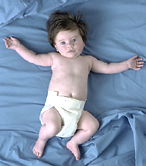
THURSDAY, Feb. 7 (HealthDay News) — Infants and children who survive a bleeding stroke may be at increased risk for seizures and epilepsy, a new study finds.
Each year in the United States, about six and a half newborns and children out of every 100,000 suffer strokes. About half of the strokes are bleeding strokes, typically caused by the rupturing of weakened or malformed blood vessels.
In this study, researchers looked at 73 infants and children, ranging from newborns to 18 years old, who suffered bleeding in their brain tissue, a type of stroke called intracerebral hemorrhage.
About 60 percent of the newborns and 43 percent of the older children had visible seizures at the time of the stroke or within one week after the stroke. Of the 32 patients who had continuous brain monitoring, 28 percent had seizures that would otherwise have gone undetected.
The researchers plan to explore whether these subtle seizures are a risk factor for more seizures, epilepsy or other problems over the long-term, according to the study.
The findings were scheduled for presentation Thursday at the American Stroke Association’s annual meeting in Honolulu. The study also will be published simultaneously in the journal JAMA Neurology.
The investigators also found that 13 percent of the patients developed epilepsy within two years, and that those who had elevated pressure in the brain that required medical or surgical treatment were more likely to have seizures and epilepsy later.
“Information on the risk for later seizures and epilepsy provides practitioners with concrete numbers that can be presented to families,” study lead author Dr. Lauren Beslow, an instructor of pediatrics and neurology at Yale University, said in an American Heart Association news release.
“While an estimate of 13 percent may seem low at two years, the rate of epilepsy might be greater at later points,” she added.
More information
The Nemours Foundation has more about children and strokes.

